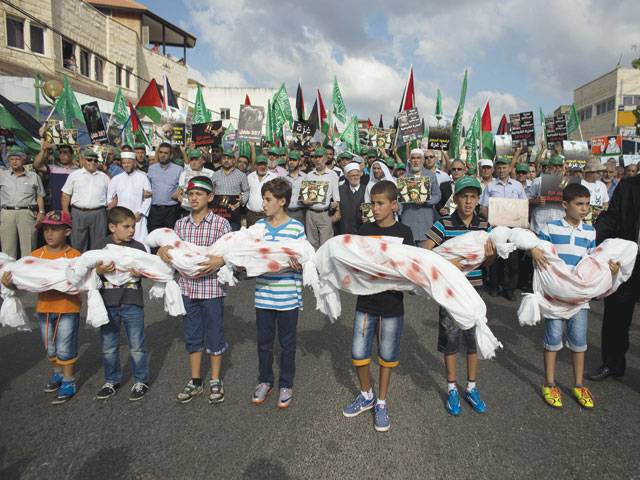Ask any child in Gaza to do a drawing and the resulting picture is likely to be a house being bombed by a fighter plane.
In the strife-torn Palestinian enclave, thousands of children are suffering from the trauma of war but resources to help them are scarce. At a school in the northern town of Jabaliya which has been converted into a refuge, specialist teachers hand out paper and coloured crayons to a motley band of shaken up children, asking them to draw whatever is in their head.
Jamal Diab, a nine-year old with red flecks in his brown hair, draws his dead grandfather. Under the drawing, he writes in Arabic: ‘I am sad because of the martyrs.’ ‘A few days ago, aircraft bombarded our house. We had to leave quickly and leave everything behind. It was dangerous,’ the lad breathes timidly as he shows his drawing.
Tiny seven-year old Bara Marouf shows a drawing of his grandfather without any legs. He was seriously wounded in an air strike. In the classroom, the same sketch comes up repeatedly: an aircraft filling the sky and bombarding a house, subtitled with the caption ‘I want to go home’.
‘Who is afraid of aircraft?’ the teacher asks the children sitting in a circle on a mat. Immediately little hands push towards the sky and high-pitched voices clamour: ‘Me’, ‘me’, ‘me’. ‘Me, I’m afraid of missiles and planes. Half our house was destroyed. We left it to come here,’ explains Itimad Subh, an 11-year-old girl with sparkling eyes.
‘They blame themselves’
According to the United Nations Children’s Fund, UNICEF, about 300 children have been killed since the start on July 8 of Israel’s offensive against Hamas militants firing rockets into the Jewish state. Those who are still alive try not to internalise too much the violence they have experienced, seen and heard.
Inside the school, groups of youths attend half-hour sessions one after the other. The two teachers, patient and exhausted, their faces enclosed in a tight veil, ask the children to jump on the spot and call out, then to wave their arms like someone disco dancing, to expel accumulated black thoughts, frustration and stress.
‘The children have all lived extreme experiences,’ says Dr. Iyad Zaqut, a psychiatrist who manages the United Nations community mental health programmes in the Gaza Strip. ‘It is very difficult for children to grasp what is happening, why their life is at risk, why they have to leave their homes, why they have to resettle, why they witness very traumatising scenes,’ Zaqut said.
‘To prevent children from processing and thinking about all these issues, we try to distract them, to help them live some joy, to have a little fun inside the shelter. ‘Generally, when they are exposed to traumatic events, the way they perceive the incident can be very distorted, they might blame themselves, they might blame their neighbours and this blaming is very harmful,’ the psychiatrist said. ‘We try to reprocess these distorted ideas,’ he explained, noting that he has diagnosed cases of post-traumatic stress and adolescent depression.
- No therapy in wartime -
But it is hard to make much progress with the therapy. In the Gaza Strip, 460,000 people - more than a quarter of the population - have been displaced by the fighting and have gone to stay with relatives or found refuge at UN shelters. Fewer than 100 specialist teachers are ‘treating’ more than 100,000 children. Only in exceptional cases do the children have access to one-on-one meetings with psychologists and psychiatrists. And even fewer get a follow up.
Gaza has been in the firing line of military operations in 2008-2009 and again in 2012 but the consequences have been greater during this current war between Israel and Hamas. UNICEF estimates that 326,000 minors in Gaza are in need of psychological help. The children and adolescents sheltering in the UN centres can at least attend the group classes but hundreds of thousands of others affected by the war are left to wander unhelped through devastated neighbourhoods.–AFP
Saturday, April 20, 2024
Children of Gaza face struggle to conquer war trauma

Caption: Children of Gaza face struggle to conquer war trauma
8:27 AM | April 19, 2024
8:09 AM | April 19, 2024
Pak economy improving, funds will be provided on request: IMF
9:57 PM | April 19, 2024
Minister advocates for IT growth with public-private collaboration
9:57 PM | April 19, 2024
Judges' letter: IHC seeks suggestions from all judges
9:55 PM | April 19, 2024
Formula 1 returns to China for Round 5
9:05 PM | April 19, 2024
Germany head coach Julian Nagelsmann extends contract till 2026 World Cup
9:00 PM | April 19, 2024
A Tense Neighbourhood
April 19, 2024
Dubai Underwater
April 19, 2024
X Debate Continues
April 19, 2024
Hepatitis Challenge
April 18, 2024
IMF Predictions
April 18, 2024
Kite tragedy
April 19, 2024
Discipline dilemma
April 19, 2024
Urgent plea
April 19, 2024
Justice denied
April 18, 2024
AI dilemmas unveiled
April 18, 2024
ePaper - Nawaiwaqt
Advertisement
Nawaiwaqt Group | Copyright © 2024





